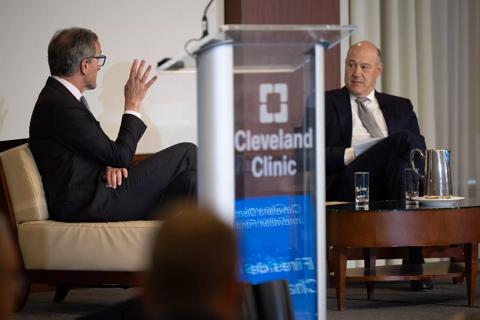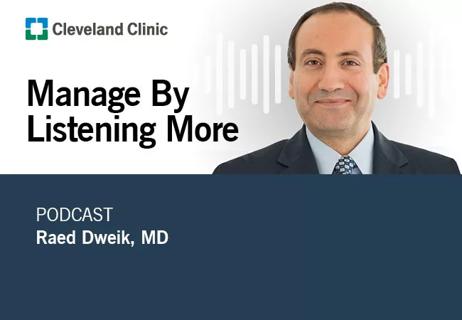Advertisement
Nursing leaders, other executives do patient rounding

During monthly executive leadership rounding at Cleveland Clinic’s main campus two years ago, frontline nurses on a medical-surgical unit mentioned that they didn’t always have access to IV pumps for medication delivery. Hospital leaders heard the complaint and worked with the Department of Clinical Engineering to resolve the problem. If an IV pump is unavailable, staff now call a five-digit number — 24 hours a day, seven days a week —and receive a clean, packaged pump within 30 minutes.
Advertisement
Cleveland Clinic is a non-profit academic medical center. Advertising on our site helps support our mission. We do not endorse non-Cleveland Clinic products or services. Policy
“To this day, nurses still sing the praises of this change in practice,” says Kelly Hancock, MSN, RN, NE-BC, Executive Chief Nursing Officer. “We were able to improve their work environment and impact patients. That’s powerful.”
Cleveland Clinic instituted executive leadership rounding at its main campus three years ago and at its eight Northeast Ohio community hospitals (and one affiliate hospital) in December 2012. Each month, the executive team, their direct reports, institute administration, and physician, nursing and other nonphysician leadership break into teams of three and round at assigned inpatient and outpatient locations. They listen to issues and suggestions from frontline staff and use that feedback to enhance the patient and caregiver experience.
“All of us are caregivers, no matter what our role,” says Hancock. “Executive leadership rounding embodies that concept. It helps us further our guiding principle of putting patients first.”
There are three key components to executive leadership rounding:
During the opening session, leaders receive instructions and celebrate exceptional caregivers. They also discuss the focus topic for that month’s rounding. For instance, one month the team discussed the significance of intermittent pneumatic compression devices for preventing venous thromboembolism. When leaders rounded, they talked to patients about the importance of wearing the devices.
Afterward, leaders break into assigned teams and round on designated areas for about 75 minutes. They document comments and observations on a form provided by the Office of Patient Experience, which oversees leadership rounding. During the first year, more than 200 multidisciplinary leaders rounded on 92 inpatient and outpatient units on Cleveland Clinic’s main campus alone.
The process ends with the debriefing session. Leaders collectively discuss the rounding and share patient and caregiver stories. Then the Office of Patient Experience collects the forms, enters all comments in a database, summarizes the results and sends summaries to each participant. Leaders are charged with making any necessary changes that fall under their purview.
Advertisement
The Office of Patient Experience tracks comments by placing them in 18 categories, ranging from hospital environment to pain management. “We’re looking for things we can fix,” says Rita Spirko, MSN, RN, Program Manager in the Office of Patient Experience. “We follow all issues from ‘open’ to ‘in progress’ to ‘closed.’”
Executive leadership rounding achieves many goals: It helps improve patient care, caregiver engagement and environmental conditions. “As a bedside nurse, it makes me feel like my voice is heard,” says Brian Holbrook, RN, a nurse in the emergency department (ED). “The leaders want to hear how things are going, what we need and what they can do to make things better.”
Holbrook recalls a rounding session when the director of environmental services visited the ED. Holbrook aired concerns about the time it took to get beds cleaned and curtains between beds changed. The delay led to longer patient waiting times. “We voiced our concerns, and now wait times to get beds cleaned are better than ever, especially in the ED,” he says.
Rounding is equally valuable for executive leaders. “It gives me an opportunity to engage with frontline staff and see how my job impacts what’s happening at the patient level,” says Dana Wade, MSN, RN, CNS-BS, CPHQ, Associate Chief Nursing Officer for Quality and Practice. “I’ve heard employees’ concerns, many of which can be corrected quickly.” For example, ED nurses shared their apprehension about workplace safety when helping patients out of cars during emergent situations. Their comments prompted leaders from the ED and the Protective Services Administration to arrange for protective service officers to be regularly stationed in the ED area.
Executive leadership rounding also allows leaders to observe positive developments taking place on units, many of which can be replicated or used to shape best-practice strategies across the health system.
Hancock witnessed a best practice on a cardiothoracic step-down floor. Two nurses were reporting off during a shift change. Rather than exchange information at the nurses’ station, they took a workstation on wheels and met in the patient’s room. “They included the patient, asking questions such as ‘Did the pain meds help you?’” says Hancock. Cleveland Clinic subsequently applied this shift-to-shift reporting strategy across the enterprise to improve the patient experience.
“I’m constantly surprised by the power of executive leadership rounding,” says Hancock. “It has influenced the engagement of our front-line staff, and our patients appreciate that we as leaders take time to make sure we’re meeting their needs.”
Advertisement
Advertisement

Interactive Zen Quest experience helps promote relaxing behaviors

Cleveland Clinic and IBM leaders share insights, concerns, optimism about impacts

Cleveland Clinic partners with Palantir to create logistical command center

A Q&A with organizational development researcher Gina Thoebes

Cleveland Clinic transformation leader led development of benchmarking tool with NAHQ

Raed Dweik, MD, on change management and the importance of communication

Small business owners expand their networks and gain new insights

Leadership pearls from Margaret McKenzie, MD, hospital vice president